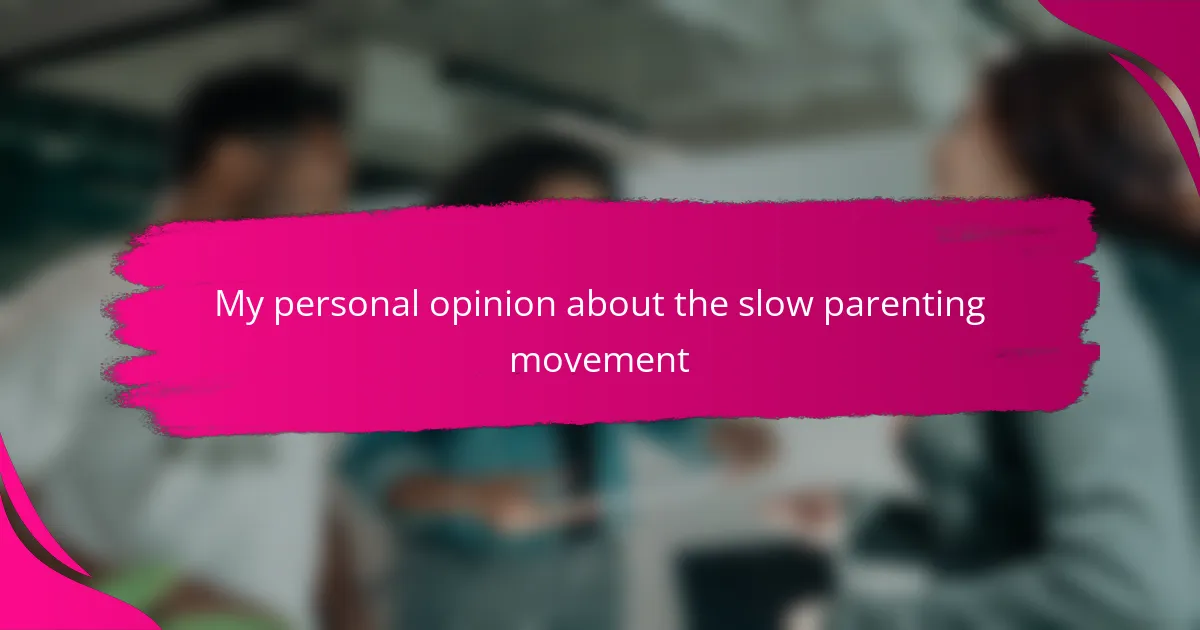Key takeaways
- Slow parenting emphasizes quality time and presence, allowing children to explore at their own pace, fostering creativity and independence.
- Benefits of slow parenting include enhanced emotional well-being, increased confidence, and the development of problem-solving skills in children.
- Challenges include societal pressures, personal expectations, and feelings of isolation when pursuing a less conventional parenting approach.
- Slow parenting serves as a counterbalance to traditional parenting methods by prioritizing a child’s natural rhythm and personal growth over strict schedules and milestones.
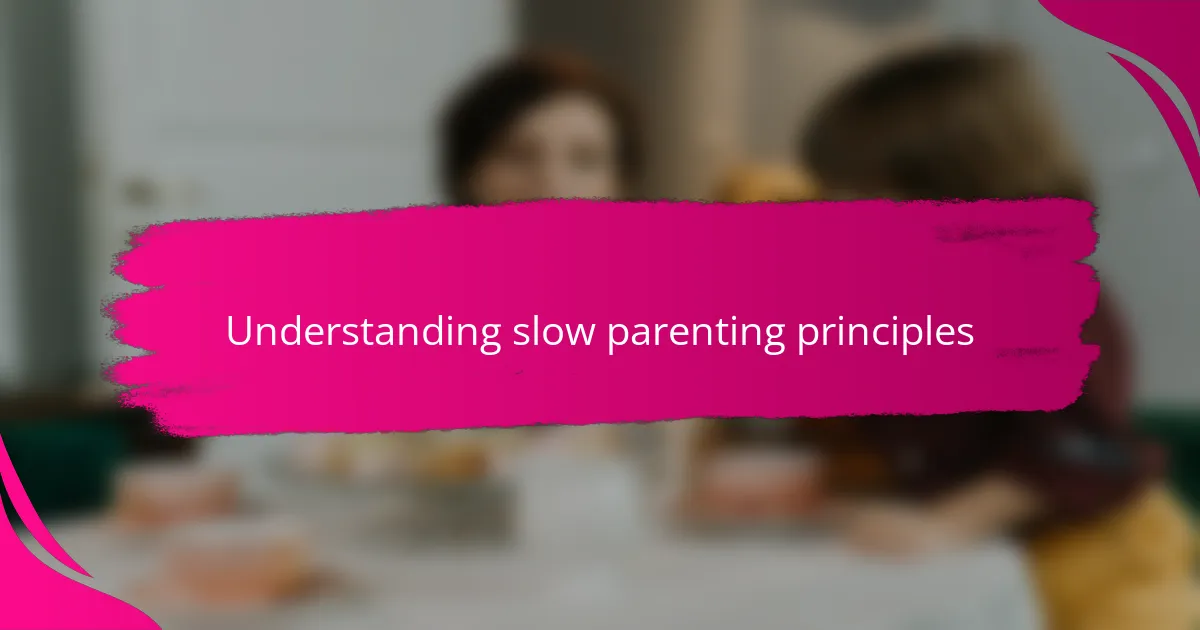
Understanding slow parenting principles
Slow parenting, to me, feels like a gentle pause in a world racing forward. It’s about valuing quality time over hurried schedules and allowing kids to explore at their own pace. Have you ever noticed how rushing from one activity to another sometimes steals the simple joys of childhood?
What intrigues me most is the emphasis on presence—being truly attentive rather than physically there but distracted. I’ve found that when I slow down, I connect more deeply with my child’s thoughts and feelings. It’s surprising how much richer those moments become when you’re not glued to a clock.
This approach also asks us to trust our children’s natural curiosity and resilience. Instead of constantly steering them, slow parenting invites us to watch and support as they navigate the world, sometimes stumbling but always learning. Doesn’t it make you wonder how much more confident our kids might be if we gave them that space?
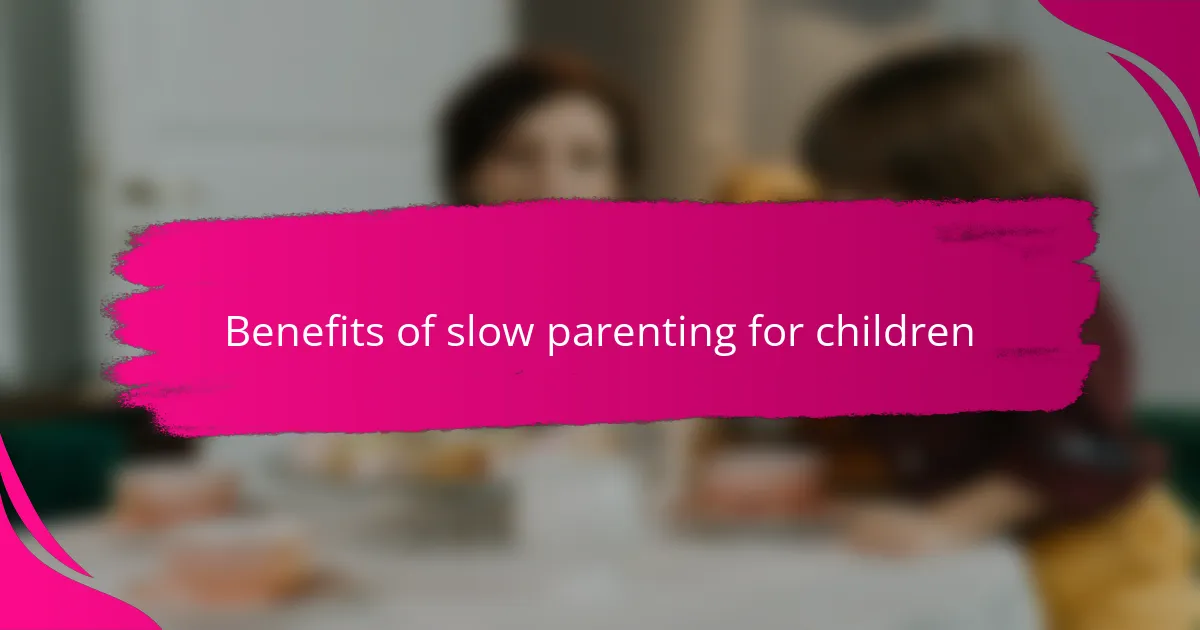
Benefits of slow parenting for children
One of the biggest benefits I’ve seen with slow parenting is how it allows children to cultivate patience and creativity. When they’re not rushed, kids have the freedom to daydream, imagine, and explore ideas deeply. Haven’t you noticed how some of a child’s best discoveries happen during those quiet, unstructured moments?
Another thing I appreciate is how slow parenting supports emotional well-being. By creating space for kids to express themselves without pressure, they often become more secure and resilient. I’ve witnessed firsthand how my child’s confidence grew simply by knowing I’m there to listen fully, not just check off tasks.
Finally, I think slow parenting helps children develop a stronger sense of independence. When given the time and trust to solve problems on their own, they learn to make decisions and cope with challenges. It’s rewarding to see them tackle obstacles without immediate intervention, isn’t it? This kind of self-reliance feels like a priceless gift for their future.
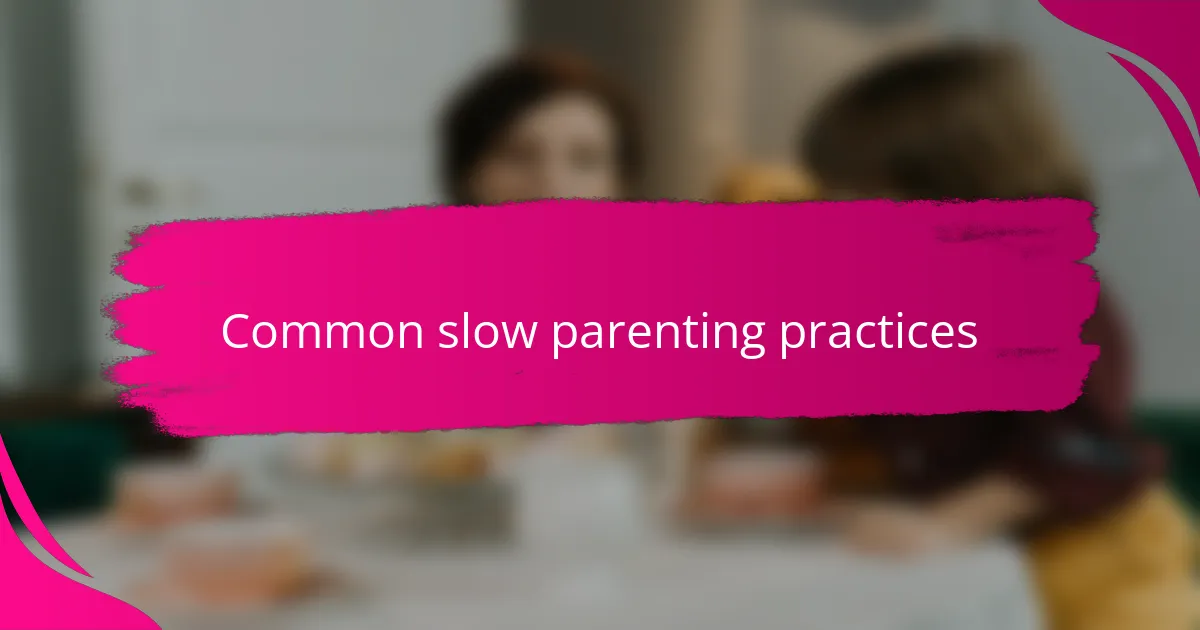
Common slow parenting practices
One of the slow parenting practices I value most is limiting overscheduling. Instead of packing every hour with activities, I let my child’s interests guide our days, which has led to some unexpected and delightful discoveries. Have you ever noticed how much richer playtime becomes when it’s unplanned and free?
Another practice I often use is prioritizing presence over multitasking. I make it a point to put away my phone and really listen during our conversations. This simple habit has deepened our connection in ways I didn’t expect—it’s amazing how much kids open up when they feel truly seen.
I also encourage my child to solve problems on their own before stepping in. It’s hard to resist jumping in, but I’ve noticed that stepping back builds their confidence and creativity. Doesn’t it feel incredible when they surprise you with a solution you hadn’t considered?
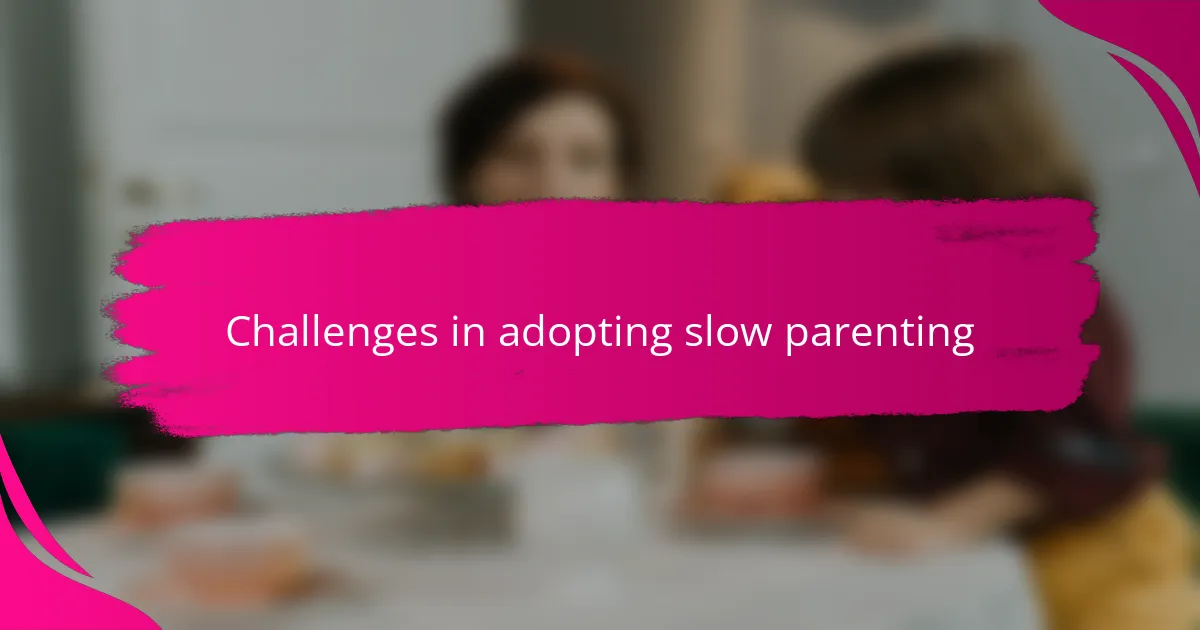
Challenges in adopting slow parenting
Adopting slow parenting hasn’t been without its hurdles for me. I often find myself wrestling with the pressure to keep up with society’s fast pace—everyone seems to have their kids enrolled in multiple activities, and it’s tempting to do the same. Have you ever felt that tug between wanting to slow down but fearing your child might miss out?
Another challenge is managing my own expectations. Sometimes, I get impatient when progress isn’t immediate, or when my child takes longer to learn something new. It’s a real test of patience to remind myself that growth has its own timing, and that’s okay.
Lastly, I’ve noticed it can be lonely at times. Not everyone around me shares this philosophy, and sometimes I second-guess if I’m doing the right thing. Have you experienced that kind of isolation when choosing a less conventional path? It’s a reminder that slow parenting requires confidence and trust in your own instincts.
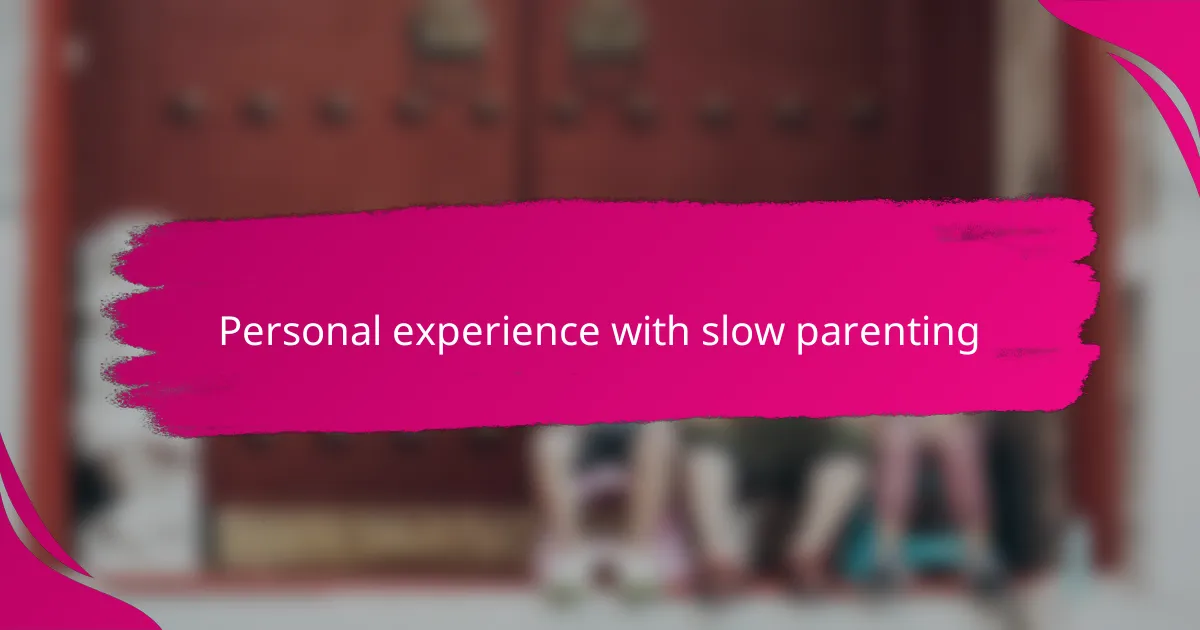
Personal experience with slow parenting
When I first tried slow parenting, I was surprised by how much calmer our days felt without the constant rush of activities. I remember one afternoon when my child spent hours building a simple cardboard fort, completely absorbed and joyful—I wouldn’t have had that moment if we stuck to a strict schedule. Have you ever felt the magic in those unhurried, creative bursts?
There were times when I doubted if slowing down was really helping my child grow, especially when friends praised their kids’ packed calendars. But then I noticed a change: my child became more curious and confident, asking questions and exploring ideas independently. It made me realize that sometimes less really is more when it comes to nurturing growth.
Of course, slow parenting hasn’t been perfect. I still catch myself feeling anxious when things don’t go according to a certain timeline. Yet, each time I let go of control and watch my child take the lead, I feel a quiet satisfaction and deeper trust in their natural pace. Doesn’t parenting feel a bit more rewarding when you witness their unique journey unfold?
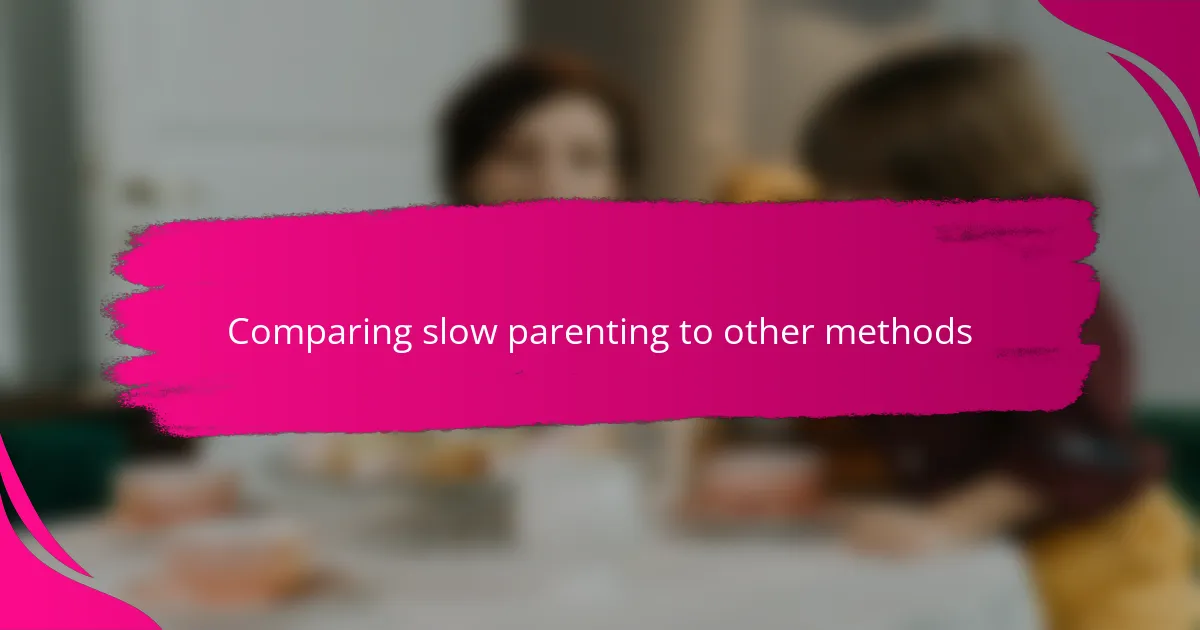
Comparing slow parenting to other methods
When I compare slow parenting to more traditional methods, I often notice how quickly the latter can become a series of checklists and achievements. It sometimes feels like other approaches prioritize milestones and schedules over the child’s natural rhythm. Have you ever felt caught in that whirlwind, wondering if you’re missing out on just being present with your child?
In contrast, slow parenting invites us to step back and observe, which can feel both liberating and challenging. While some methods push constant involvement or intervention, slow parenting trusts in the child’s ability to grow through experience and occasional mistakes. I remember resisting this at first, thinking I had to fix everything immediately, but letting go brought surprising confidence—not just to my child, but to me as a parent.
That said, I don’t see slow parenting as the “right” way exclusively; it’s more like a calming counterbalance to the high-speed styles out there. It’s a deliberate choice to value depth over breadth, connection over competition. If you’ve tried both, you might find slow parenting slows down the noise and lets the true essence of childhood shine through.
